Abstract
The biosynthetic pathway for the cyanogenic glucoside dhurrin derived from tyrosine has been studied in vitro by using [18O]oxygen and a microsomal enzyme system obtained from etiolated sorghum seedlings. The products formed were purified by HPLC and TLC, and the incorporation of [18O]oxygen was monitored by mass spectrometry. In the presence of NADPH and [18O]dioxygen, L-tyrosine is converted to (E)- and (Z)-p-hydroxyphenylacetaldehyde oxime with quantitative incorporation of an [18O]oxygen atom into the oxime function. The first step in this conversion is the N-hydroxylation of L-tyrosine to N-hydroxytyrosine. Administration of N-hydroxytyrosine as a substrate results in the production of 1-nitro-2-(p-hydroxyphenyl)ethane in addition to (E)- and (Z)-p-hydroxyphenylacetaldehyde oxime, with quantitative incorporation of a single [18O]oxygen atom in all three products. These data demonstrate that the conversion of N-hydroxytyrosine to p-hydroxyphenylacetaldehyde oxime involves additional N-hydroxylation and N-oxidation reactions giving rise to the formation of 2-nitro-3-(p-hydroxyphenyl)propionate, which by decarboxylation produces aci-1-nitro-2-(p-hydroxyphenyl)ethane. Both compounds are additional intermediates in the pathway. The two [18O]oxygen atoms introduced by the N-hydroxylations are enzymatically distinguishable as demonstrated by the specific loss of the oxygen atom introduced by the first N-hydroxylation reaction in the subsequent conversion of aci-1-nitro-2-(p-hydroxyphenyl)ethane to (E)-p-hydroxyphenylacetaldehyde oxime. A high flux of intermediates through the microsomal enzyme system is obtained with N-hydroxytyrosine as a substrate. This renders the conversion of the aci-nitro compound rate limiting and results in its release from the active site of the enzyme system and accumulation of the tautomeric nitro compound.
Full text
PDF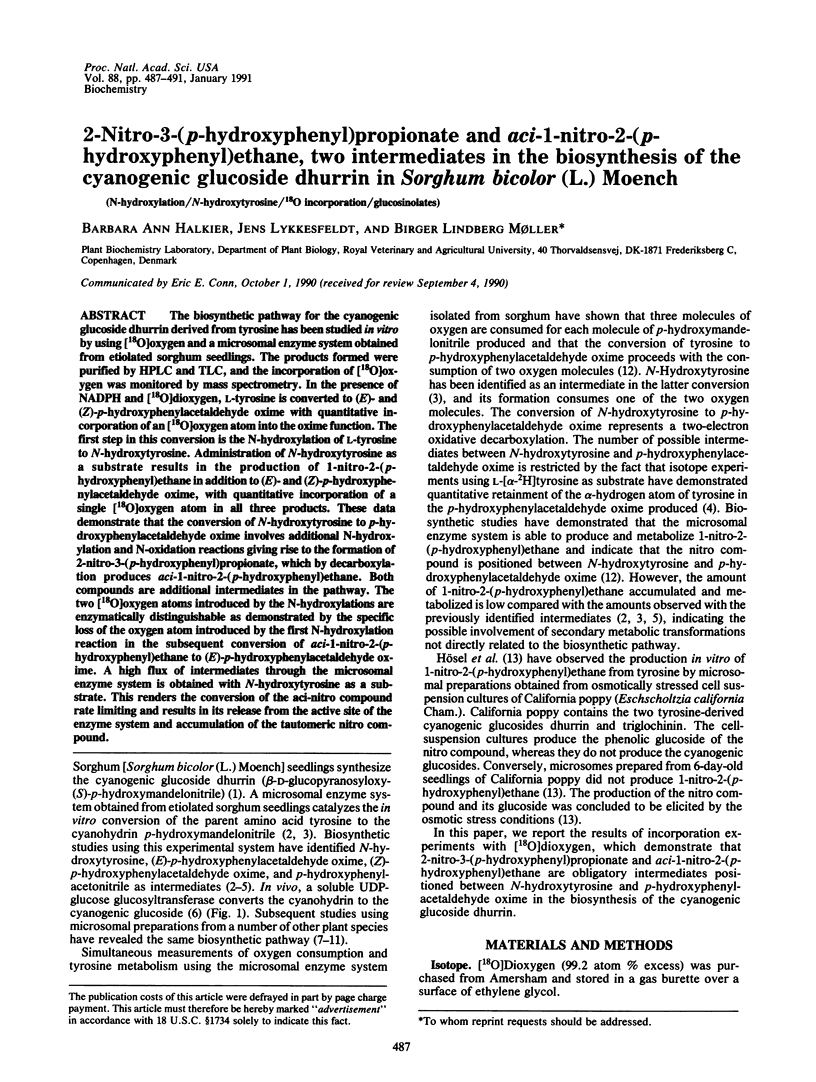
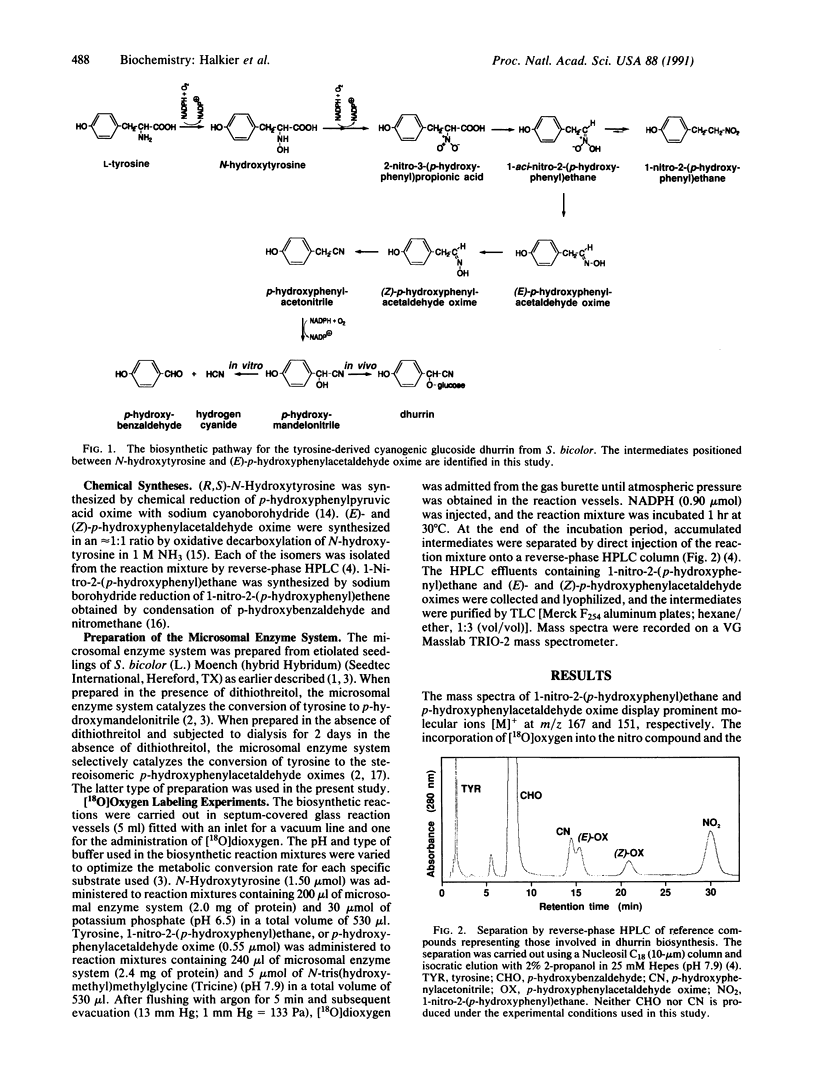
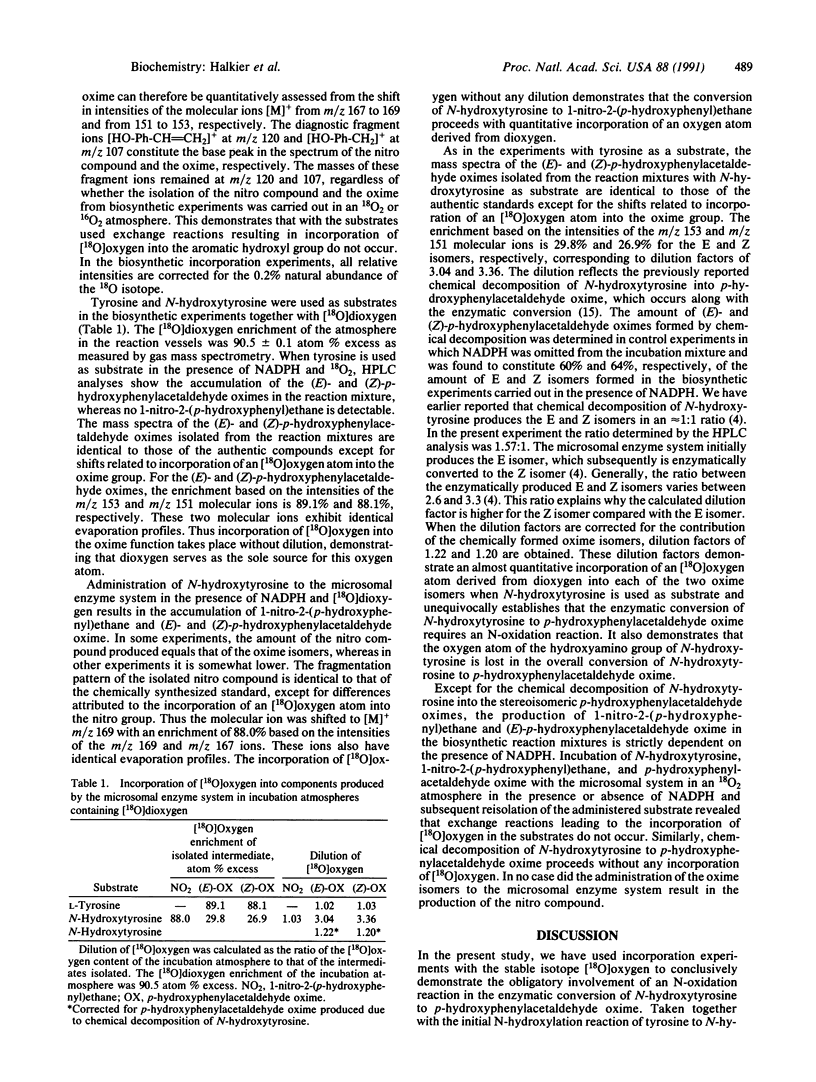
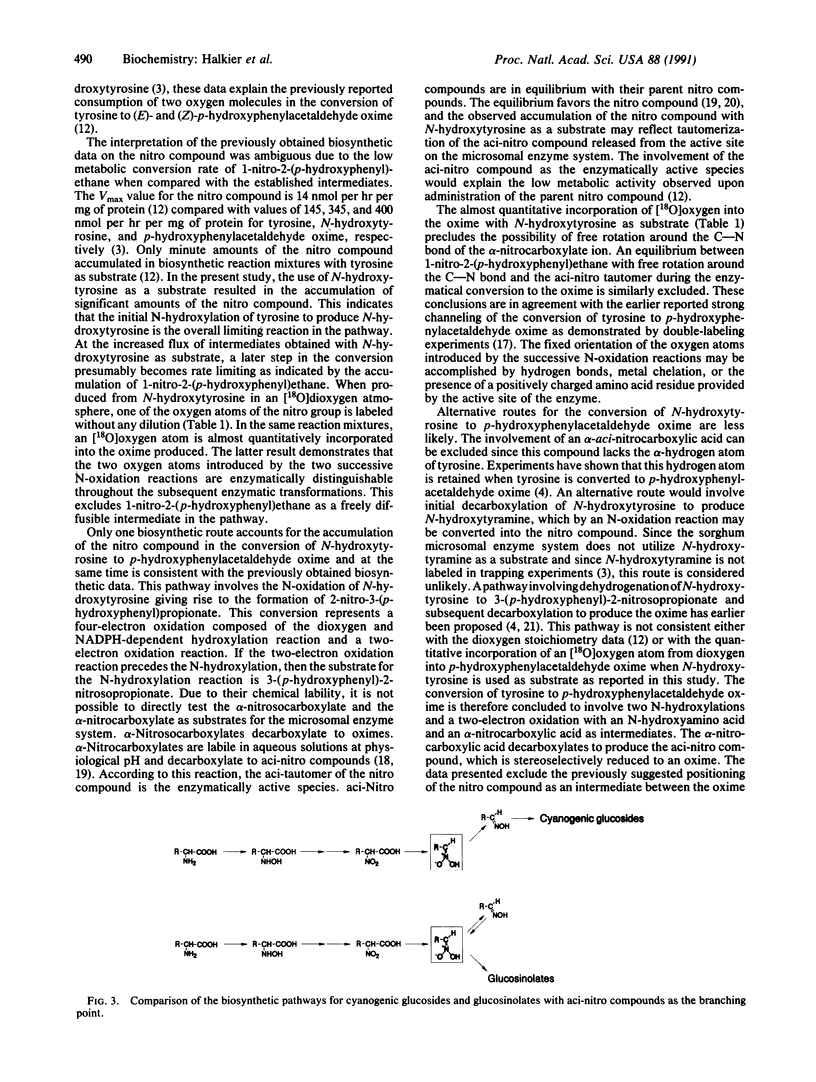
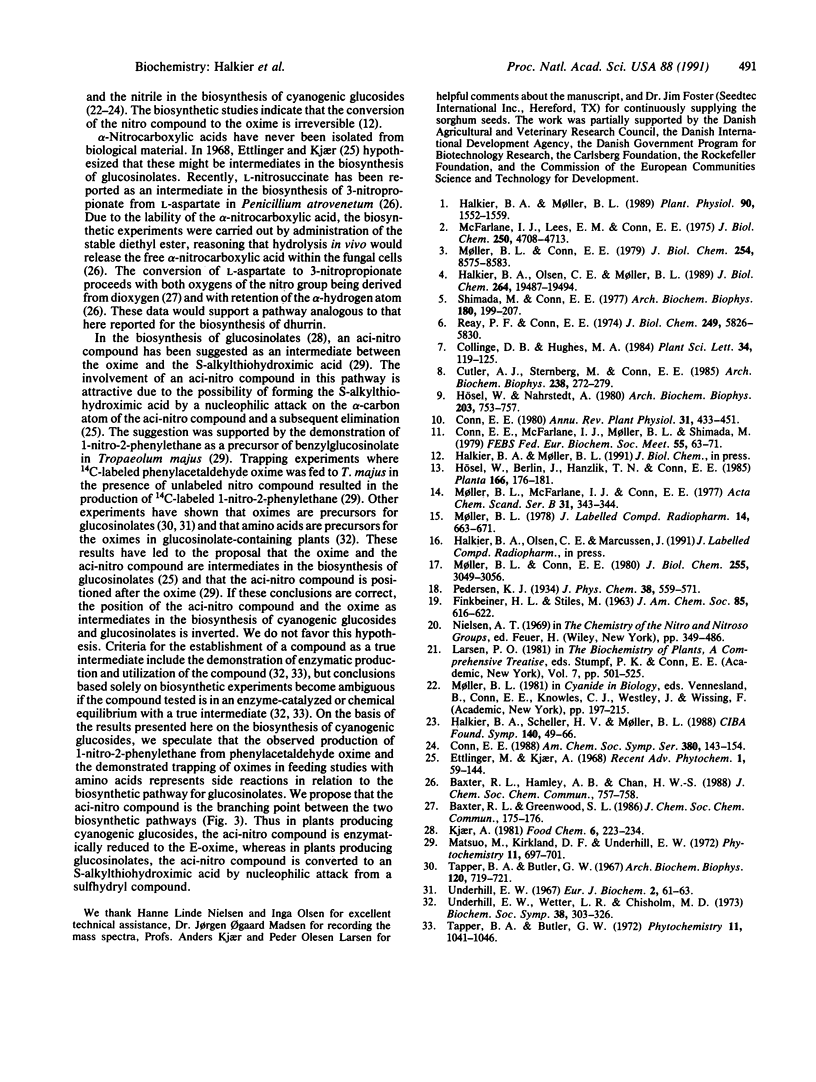
Selected References
These references are in PubMed. This may not be the complete list of references from this article.
- Cutler A. J., Sternberg M., Conn E. E. Properties of a microsomal enzyme system from Linum usitatissimum (linen flax) which oxidizes valine to acetone cyanohydrin and isoleucine to 2-methylbutanone cyanohydrin. Arch Biochem Biophys. 1985 Apr;238(1):272–279. doi: 10.1016/0003-9861(85)90165-1. [DOI] [PubMed] [Google Scholar]
- Halkier B. A., Møller B. L. Biosynthesis of the Cyanogenic Glucoside Dhurrin in Seedlings of Sorghum bicolor (L.) Moench and Partial Purification of the Enzyme System Involved. Plant Physiol. 1989 Aug;90(4):1552–1559. doi: 10.1104/pp.90.4.1552. [DOI] [PMC free article] [PubMed] [Google Scholar]
- Halkier B. A., Olsen C. E., Møller B. L. The biosynthesis of cyanogenic glucosides in higher plants. The (E)- and (Z)-isomers of p-hydroxyphenylacetaldehyde oxime as intermediates in the biosynthesis of dhurrin in Sorghum bicolor (L.) Moench. J Biol Chem. 1989 Nov 25;264(33):19487–19494. [PubMed] [Google Scholar]
- Halkier B. A., Scheller H. V., Møller B. L. Cyanogenic glucosides: the biosynthetic pathway and the enzyme system involved. Ciba Found Symp. 1988;140:49–66. doi: 10.1002/9780470513712.ch5. [DOI] [PubMed] [Google Scholar]
- Hösel W., Nahrstedt A. In vitro biosynthesis of the cyanogenic glucoside taxiphyllin in Triglochin maritima. Arch Biochem Biophys. 1980 Sep;203(2):753–757. doi: 10.1016/0003-9861(80)90235-0. [DOI] [PubMed] [Google Scholar]
- MacFarlane I. J., Lees E. M., Conn E. E. The in vitro biosynthesis of dhurrin, the cyanogenic glycoside of Sorghum bicolor. J Biol Chem. 1975 Jun 25;250(12):4708–4713. [PubMed] [Google Scholar]
- Møller B. L., Conn E. E. The biosynthesis of cyanogenic glucosides in higher plants. Channeling of intermediates in dhurrin biosynthesis by a microsomal system from Sorghum bicolor (linn) Moench. J Biol Chem. 1980 Apr 10;255(7):3049–3056. [PubMed] [Google Scholar]
- Møller B. L., Conn E. E. The biosynthesis of cyanogenic glucosides in higher plants. N-Hydroxytyrosine as an intermediate in the biosynthesis of dhurrin by Sorghum bicolor (Linn) Moench. J Biol Chem. 1979 Sep 10;254(17):8575–8583. [PubMed] [Google Scholar]
- Reay P. F., Conn E. E. The purification and properties of a uridine diphosphate glucose: aldehyde cyanohydrin beta-glucosyltransferase from sorghum seedlings. J Biol Chem. 1974 Sep 25;249(18):5826–5830. [PubMed] [Google Scholar]
- Shimada M., Conn E. E. The enzymatic conversion of p-hydroxyphenylacetaldoxime to p-hydroxymandelonitrile. Arch Biochem Biophys. 1977 Apr 15;180(1):199–207. doi: 10.1016/0003-9861(77)90026-1. [DOI] [PubMed] [Google Scholar]
- Underhill E. W. Biosynthesis of mustard oil glucosides: conversion of phenylacetaldehyde oxime and 3-phenylpropionaldehyde oxime to glucotropaeolin and gluconasturtiin. Eur J Biochem. 1967 Jul;2(1):61–63. doi: 10.1111/j.1432-1033.1967.tb00106.x. [DOI] [PubMed] [Google Scholar]
- Underhill E. W., Wetter L. R., Chisholm M. D. Biosynthesis of glucosinolates. Biochem Soc Symp. 1973;(38):303–326. [PubMed] [Google Scholar]


